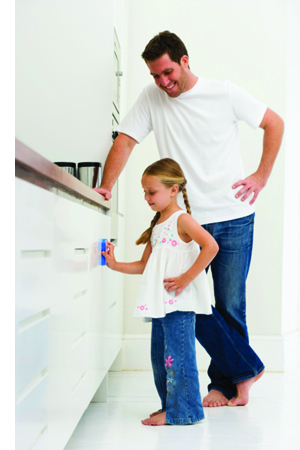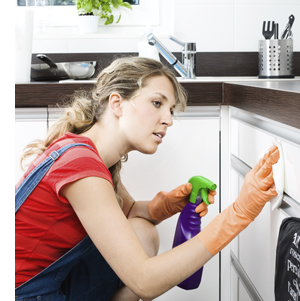Care for your Cabinets
SMART START
 Once installed, it is tempting to immediately begin by putting items in drawers and cabinets. You would like to use your beautiful new cabinets, however, we suggest you do the following first:
Once installed, it is tempting to immediately begin by putting items in drawers and cabinets. You would like to use your beautiful new cabinets, however, we suggest you do the following first:
With a damp (not wet) soft cloth, wipe down all the cabinetry, including the inside of drawers, cabinets, and all hardware. Use an additional clean soft cloth to dry. If you use a glass cleaner on any glass doors, be sure to protect the wood surfaces as ammonia in the glass cleaner can damage the finish on your cabinets. Whenever possible, it is best to remove the glass from the cabinet in order to clean it.
Once you’ve wiped down your cabinets, you can polish the doors, drawers and front frames with a good quality furniture polish that does not contain silicone, ammonia, or an alkaline based polish. Buff the polish with a soft cloth to maintain the furniture quality finish.
Because your cabinets have both water resistant powder coated shelving and laminated interiors, you do not need to line them with shelf paper. Instead, wipe them with a soft cloth in the same way that you wipe down the exteriors.
If you have any questions about installation, features, options or your cabinets, contact your dealer/installer immediately. It’s always easier to take care of the questions early, rather than after you’ve had the cabinets for several months.
SMART CARE
 Smart Cabinetry uses only the finest of materials and process during the manufacturing and assembly of your cabinets. Raw materials like powder coated finishes, laminates, diamond tooling and high solid coatings assure our customers a quality cabinet upon arrival. Unfortunately, over time in our every day lives accidents do and will occur. When they do occur, like any fine-quality furniture surface, your cabinets should be treated as such, please understand the SMART Guide below. A thorough understanding is necessary to increase the life or maintain the beauty of your cabinets.
Smart Cabinetry uses only the finest of materials and process during the manufacturing and assembly of your cabinets. Raw materials like powder coated finishes, laminates, diamond tooling and high solid coatings assure our customers a quality cabinet upon arrival. Unfortunately, over time in our every day lives accidents do and will occur. When they do occur, like any fine-quality furniture surface, your cabinets should be treated as such, please understand the SMART Guide below. A thorough understanding is necessary to increase the life or maintain the beauty of your cabinets.
- DO NOT allow water, chemicals (alkaline-based detergents, ammonia, vinegar, or abrasive cleaning products), and hot or acid food spills to set on your cabinets.
- ALWAYS immediately, wipe up spills as quickly as possible. Prolonged exposure to spills, including food, water or other liquids, or to oil and grease splatters, can cause permanent discoloration or damage to your cabinets.
- ALWAYS use a soft cloth. DO NOT USE coarse or abrasive cloths or materials as they may dull the finish or leave scratches that cannot be removed. DEFINITELY AVOID soap pads, scouring pads and brushes.
- DO NOT USE ammonia, products that contain ammonia, strong solvent cleaners, mineral spirits, paint thinner or any other harsh cleaning chemicals when cleaning our cabinets.
- DO NOT USE wax or a polish that contains silicone. Wax builds up on the surface and causes yellowing; silicones smudge and highlight fingerprints, and can be removed only with extreme measures.
- DO clean with a soft cotton cloth dampened with warm water is usually sufficient to clean your cabinets. If more thorough cleaning is required, use one of the following cleaning solutions: A fresh solution of dishwashing liquid mixed with warm water, or a mild all-purpose cleaner. Make sure either does not contain ammonia or silicone and is wiped up immediately. Use the mildest cleaning solution that will successfully clean your cabinets. Stronger products may damage or discolor your cabinet finish and are not recommended. After cleaning, wipe all surfaces with a clean, damp cloth. Dry immediately, using another soft, clean cloth.
- All drawer guides, glides, and pull out trays are rated for different weight capacities. Periodically check to make sure that you are not placing too heavy a load on shelves and drawer bottoms. This is especially important with pull out trays, slide out drawers, Lazy Susan’s, and any place where heavy or unbalanced loads can shorten the life expectancy of the moving or mechanical parts.
- Avoid Moisture Damage. Avoid draping damp clothes or dishtowels over cabinet doors. This moisture can cause permanent damage — such as peeling and discoloration — to the cabinet’s finish.
- Avoid Heat Damage. The heat generated when using an oven’s self-cleaning feature is much greater than during normal cooking. If this heat escapes from the oven, it can damage your cabinets. While this is a rare circumstance, you can minimize the risk of cabinet damage by removing cabinet doors and drawers nearest the oven before using its self-cleaning feature.
- Cleaning Glass Doors. Extra care is required when cleaning glass doors. Spray an ammonia-free glass cleaner on a clean, soft, lint-free cloth or paper towel. Do not spray cleaner directly on the glass. It could seep behind the window dividers and cause damage.
- Consider window treatments that block direct sunlight exposure on your cabinetry, thereby minimizing color changes in the finish. This is especially important if you intend to add cabinets at a later date.
- Regular Dusting is permissible, a soft lint-free cotton cloth for regular dusting is recommended. Packaged dusting sheets are not required or recommended. Do not use pre-moistened dusting sheets, and do not use aerosol products made for dusting.

